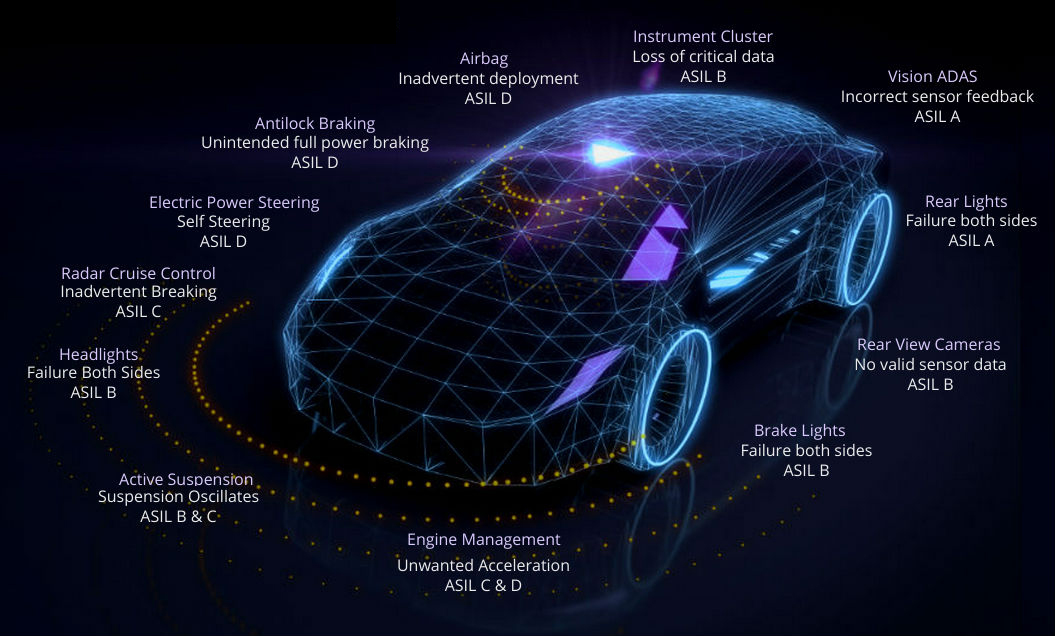Why is the Functional Safety Standard Needed?
It is the adaptation of IEC 61 580, which is applied to automotive electronics or electrical safety-related systems. These systems are made up of software and hardware components in vehicles. You can reach out to functional safety experts to help you navigate the risk-based safety standard it provides. This is key because operational safety is crucial in developing safety-critical automotive systems. You will need a functional safety team with an unparalleled track in functional safety testing. This does not apply to autonomous vehicles, as the assumption is that someone is driving. It does help you address the level of risk reduction and deals with risk classification for the pedestrians and passengers as well.
Increasing complexity throughout the automotive industry results in increased efforts to provide safety-compliant systems. For instance, modern automobiles utilize by-wire systems such as throttle-by-wire. The driver applies pressure on the accelerator, and a sensor in the pedal relays a signal to an electronic control unit. This control system analyzes vehicle speed, pedal position, and engine speed. It then communicates a command to the throttle body. The automotive industry’s challenge is testing and validating systems such as throttle-by-wire. The goal of ISO 26262 functional safety is to offer unifying safety standards for all automotive E/E systems and help in your functional safety management. You increase your levels of safety by strengthening any passive safety systems or controlling systematic failure that may occur.
The DIS – Draft International Standard of ISO 26262 was published in June 2009. From the moment of the publication of the draft, ISO 26262 has gotten more traction in the automotive industry. Due to a public draft standard being available, lawyers treat ISO 26262 as the technical safety state of the art. The technical condition of the art is the highest level of development of a process or device at a particular time. As outlined by German law, car producers are generally liable for damage to a person caused by the malfunctioning of a product. If the current technical equipment could not have detected the malfunction, the liability is not included [German law on product liability (§ 823 Abs. 1 BGB, § 1 ProdHaftG)].
Putting into practice ISO 26262 permits leveraging a usual standard to measure how safe a system will be in service. It also gives you the ability to reference particular parts of your system due to a common vocabulary presented by the standard. This is similar to other safety-critical application areas; a common standard offers a way to measure how safe your system is from unreasonable risk.
This system does not deal with safety hazards related to the release of energy, fires, corrosion, toxicity, flammability, smoke, reactivity, or electric shock.
Table of Content:
- Critical Features of ISO 26262
- Qualification of Hardware Components
- Qualification of Software Components
- “Proven in Use” Argument
- Applying to Current Processes
- Hardware and Software Tools Qualification
Critical Features of ISO 26262

ISO 26262 utilizes a system of techniques to manage functional safety and regulates automotive product development on a system, hardware, and software level. The ISO 26262 standard gives regulations and recommendations throughout the product development process, from conceptual development to decommissioning. It provides details on assigning an acceptable risk level to a system or component and documents the overall testing process. In general, ISO 26262:
- It provides automotive safety lifecycle activities (service, operation, development of software, management of functional safety, production, service, decommissioning) and supports tailoring the necessary activities during these lifecycle phases.
- It facilitates an automotive-specific risk-based approach for discovering risk classes, ASILs.
- It utilizes Automotive Safety Integrity Levels (ASILs) for specifying the item’s necessary safety requirements for achieving an acceptable level of residual risk.
- It offers the criteria for validation and confirmation of safety measures to ensure a sufficient and acceptable system level of safety is achieved.
Automotive Safety Lifecycle
Ten volumes make ISO 26262. It is created for series production cars and holds sections specific to automotive. For instance, section 7 of ISO 26262 specifies safety requirements for production, operation, service, and decommissioning. The ISO 26262 automotive safety life cycles recount the whole product lifecycle. This includes developing a safety plan, the need for a safety manager, and the definition of confirmation measures, such as audit, safety review, and risk assessment. These requirements are intended to develop the electric and electronic E/E systems and elements.
Classification of risks are from Level A or ASIL A to Level D or ASIL d: You can define the event as having a reasonable likelihood of causing a fatal injury or life threatening injury to moderate injuries. This paper mainly discusses the development section of the lifecycle. The development section of ISO 26262 comprises defining the system, functional safety assessment, requirements specification (technical safety requirements or software safety requirements), safety validation, production release, and system design (software design).

Automotive Safety Integrity Level (ASIL)
The Automotive Safety Integrity Level is a crucial element for ISO 26262 compliance. The ASIL is identified at the start of the entire development process (concept phase). The planned functions of the system are analyzed concerning possible safety hazards (safety risks) and expected safety goals. The Safety Integrity Level asks, “If a failure arises, what will happen to the driver and associated road users?” This review looks at specifications, evaluation of software analysis, and design analysis. The estimation of this risk, based on the probability of exposure, the possible controllability by a driver, and the potential outcome’s severity if a critical event occurs, leads to ASIL. The Safety Integrity Level does not address technologies used in the system; it is solely anchored on the damage/injury to the driver and other road users.
All safety requirements are assigned an Automotive Safety Integrity Level of ASIL level A, B, C, or D. D has the highest number of safety-critical processes and stringent testing regulations. The ISO 26262 standard distinctly identifies the minimum testing requirements depending on the ASIL of the component. This is beneficial when determining the methods you must use for the vehicle test. Once the Safety Integrity Level is selected, a safety aim for the system is formulated. This outlines the system behavior needed to ensure safety.
For instance, let us consider a windshield wiper system. The safety analysis will discover the effects of doing away with the wiper function on the driver’s visibility. The ASIL guides choosing the adequate methods for reaching a certain level of product integrity. This instruction is meant to complement current safety practices. Recent automobiles are manufactured at a high safety level, and ISO 26262 is intended to standardize certain practices. Automotive Safety Integrity Level can also be utilized in safety-oriented analysis for unique E/E safety-related systems alongside special purpose vehicles like modern vehicles designed for drivers with disabilities.
Qualification of Hardware Components
Hardware qualification has two main goals: to show how the part of ISO 26262 fits into the overall system and assess random hardware failure modes. Hardware automotive components are usually prepared by testing the function in various environmental and operational conditions. The evaluation of the hardware level is followed by the test results being analyzed with multiple numerical techniques and presented in a qualification report along with the input criteria, assumptions, and testing procedure. You can qualify essential hardware components with standard qualifications, but more complex features require evaluation through ASIL decomposition and testing.
Qualification of Software Components
Capable software components are generally well-established products re-used across projects and include libraries, operating systems, databases, and driver software. Qualifying software components involves defining resource usage and functional requirements and predicting software behavior in overload and failure situations. This process is dramatically made easier by using qualified software during automotive application software development. To qualify a software component, the standard needs testing under normal operating conditions and the insertion of faults in the system to identify how it reacts to abnormal inputs. Software errors such as data and runtime are analyzed and addressed throughout the design process.
“Proven in Use” Argument
Using the ” proven in use ” argument, hardware and software components can follow ISO 26262 requirements and the “proven in use” argument. This clause applies when a feature has been utilized in other applications with no incidents occurring. ISO 26262 also deals with older systems that have been proven in use. In numerous circumstances, it is not logical to apply a standard to a system that has been previously deployed in millions of vehicles (road vehicles or special vehicles). For example, several systems in currently manufactured cars were manufactured to a high level of safety before ISO 26262. When used in the real world, these safety-critical components have indicated that they can exhibit reliable behavior. Reliable systems unchanged from previous vehicles are still certifiable with ISO 26262. Combining certifiable features from similar applications and older, widely-deployed applications dramatically reduces system complexity.
You can get a provider who offers you: a GAP analysis assessment – suitable for the safety development processes such as risk assessment (HARA), independent safety assessments, and systems safety assessments (FTA, FMEA, among others). FMEA – Failure mode effect and diagnostic analysis (FMEDA). Failure Tree Analysis (FTA) Certification.
Applying to Current Processes
One of the main issues faced when implementing a new standard such as ISO 26262 is applying it to contemporary processes. Usually, with a new standard, pilot projects are utilized to show the implementation of the standard and its effects on existing processes. Companies already see the benefits of evaluating risk and doing hazard analysis early in the development process and applying to test throughout. The results show that ISO 26262 adapts well to current safety concepts in the industry. It is crucial for companies looking to implement 26262 to understand that the goal is to analyze risk early on in the development process, indicate the appropriate safety requirements, and fulfill these requirements through testing in the course of development.

Hardware and Software Tools Qualification
During ISO 26262 development, the test is a key component. When exposed to varying human and environmental inputs, safety-critical systems like electronic systems in vehicles, motorcycles, and mopeds must react adequately to test scenarios and stay within specified safety limits. Using high-quality test systems can improve a product’s performance, lower return rates, and increase quality management and reliability. It is estimated that the price of failure diminishes by ten times when the error is identified in production instead of in the field and drops ten times again if it is seen in design instead of production—detecting these defects and collecting the data to improve a technique or process. Driving innovation into this process through best-practice methodologies and technology insertion can generate significant cost reductions and efficiency gains. It is easy to ignore the tools and consider only the system’s design, but in reality, the tools are essential to the end user’s safety.
ISO 26262 recognizes that utilizing widely accepted software tools simplifies or automates activities and tasks required to develop functional safety of electrical, software, and electronic components that offer safety-related functions. Before explaining the particulars of the tool qualification process, it is crucial to define an essential element of tool qualification, the Tool Confidence Level.
The Tool Confidence Level
The ASIL Level and TCL determine the level of qualification required for the software development tool. Typical (or reference) use cases are developed from the inputs and outputs of the device. The gap analysis of these utilized cases leads to the determination of the TCL or Tool Confidence Level. Two particular areas are evaluated to establish the confidence level:
- The probability of a malfunctioning software tool and its erroneous output can violate any safety requirement allocated to the safety-related element or item to be developed by safety engineers.
- The likelihood of preventing or detecting such errors in its output
The Tool Confidence Level is identified as TCL1, TCL2, TCL3, or TCL4, with TCL1 being the lowest level of confidence and TCL4 being the highest level of confidence.

The Tool Qualification Process
To qualify a tool under the ISO 26262, there are many conditions. For example, you must already determine the Automotive Safety Integrity Level. The device must have a unique identification, user manual, version number, a description of the features, environment, and installation process (to name a few). ISO 26262 needs the tool qualification work products listed below:
- Software Tool Qualification Plan
- Software Tool Documentation
- Software Tool Classification Analysis
- Software Tool Qualification Report
Software Tool Qualification Plan
The STQP Software tool Qualification Plan is created early in the development life cycle of the safety-related item. It focuses on planning for the qualification of a software tool and listing the use-cases that demonstrate the device is classified with the required level of confidence. The STQP must include a version number and a unique identification of the software tool, use cases, the description, environment, user manual, and the pre-defined ASIL.
Software Tool Classification Analysis
The primary purpose of the Software Tool Classification Analysis (STCA) is to determine the Tool Confidence Level. Two main components determine the TCL. The first is the Tool Impact (TI). The second is Tool Error Detection (TD). Based on these two elements, a suitable TCL is picked.
The two classes of Tool Impact are TI1 or TI2. TI1 is used when there is an argument that there is no possibility that the malfunctioning software tool can break a safety critical bar. For all other cases, TI2 is picked. For instance, let us say that a tool produces a typo in the documentation for a specific software function. This would result in a tool impact of TI1. If the tool churns out an error that could change the system’s behavior, then TI2 will be picked. This can be thought of as a nuisance only and does not violate the test safety requirement. The Tool Error Detection is categorized as TD1 through TD3. TD1 is picked if there is a high level of confidence in the tool’s ability to detect an error, where TD3 is selected for a meager degree of certainty, frequently when it is concluded that developers can only find the error randomly.
For instance, a software tool might check a design model for errors. In this case, a static analysis of the model is performed. While static analysis is good, it cannot review all possible hazards or violations in the model. It is vital to note that this does not necessarily imply that the model is wrong; it simply means that more testing is required. This situation results in a ‘medium’ degree of confidence, or TD2.
Tool Error Detection
TD1
TD2
TD3
Tool Impact
TI1
TCL1
TCL1
TCL1
TI2
TCL1
TCL2
TCL3
The user needs to perform the tool classification for each software tool. Once the Tool Error Detection (TD) and Tool Impact (TI) are identified, a value of TCL 1 to TCL 3 is provided, depending on the required confidence level. Sometimes multiple use cases can result in numerous TCLs. In this case, the highest value of TCL is used.
Software Tool Documentation
You must provide numerous pieces of information to ensure proper usage of the software tool.
- Description of features
- Description of the installation process
- User manual
- Operating environment
- The anticipated behavior in abnormal conditions
Software Tool Qualification Report
The STQ Report: Software Tool Qualification Report holds the results and evidence that you fulfilled the tool qualification and requirements. Any erroneous outputs or malfunctions in the validation process should be analyzed and documented here.

Increased confidence in the use
A crucial functional safety aspect of tool qualification is the concept of increased confidence from use. If you can already demonstrate the qualification requirements for a given tool, further qualification is no longer required. This can drastically save on cost and time throughout the development process. But you must demonstrate qualification requirements for each safety-related item or element before being used to develop that item. To illustrate this, the tool must prove that:
- It has been utilized before for the same purpose with similar use-cases.
- The specification of the device is not altered.
- There has not been a breach of safety bars allocated to the safety-related item developed before.
For instance, you used test tool A to validate car X’s Engine Control Unit (automotive ECU software). If test tool A has not broken any safety bars and remains unchanged, you can use it to validate car Y’s ECU, given that car Y’s ECU is being used similarly to car X’s ECU.










